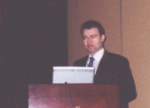
 According to Yves Dubuisson, Principal, Strategic & Business Consulting with CGEY, the Wi-Fi key success factors reside on the high rate radio access, the low costs for the operator and the end user, the pervasive access provision and the fact that it is a non regulated technology. The development of hotspot coverage density, the increase in customer equipment rate in Wi-Fi enabled laptops, the definition of more appropriate price plans and a secure customer experienced were identified as the four key drivers to boost Wi-Fi usage in Europe. His views were expressed at Wireless Communications Symposium which took place in Lisbon between 21-22 this month.
According to Yves Dubuisson, Principal, Strategic & Business Consulting with CGEY, the Wi-Fi key success factors reside on the high rate radio access, the low costs for the operator and the end user, the pervasive access provision and the fact that it is a non regulated technology. The development of hotspot coverage density, the increase in customer equipment rate in Wi-Fi enabled laptops, the definition of more appropriate price plans and a secure customer experienced were identified as the four key drivers to boost Wi-Fi usage in Europe. His views were expressed at Wireless Communications Symposium which took place in Lisbon between 21-22 this month.
A variety of providers entered European market in 2003 to capture the growth opportunities, like WISPs, incumbent operators, mobile operators and hotspot owners. In 2003 more than 10,000 hotspots were reported in Europe, although this continent was late to start deploying public hotspots. Less than 2,000 hotspots were reported in Europe at the end of 2002, he said.
Yves Dubuisson considers Wi-Fi development can be divided in three cycles: Wi-Fi network building, commercial service launching and business model creation. When building Wi-Fi network, businesses should understand risks and of opportunities of WLAN technology and define strategic positioning and partnerships for hotspot acquisition.
Prior to launching commercial services, operators should develop transversal fixed-internet-mobile strategy, design an international strategy, design an international strategy, roll-out hotspots in an industrialised manner and educate market on Wi-Fi usage.
If business want to be profitable, they should develop Wi-Fi revenues, adapt pricing policy and communication plan and analyse hotspot traffic to adjust Wi-Fi coverage, rolling-out low priority hotspots. Its also an important factor if they cold learn from facts, numbers and clients, he added.
The CGEY consultant also predicted 2004 will see an acceleration in small sites hotspot roll-out: In 2004 business users are of operators number one target as more than 70 per cent of laptops on European market are provided by companies to their mobile staff. On the other hand, mass market will be targeted in 2004/05 when Wi-Fi equipment penetration will be higher and price lower. Students will be the early adopters of the mass market.
Turning into security issues, Mr Dubuisson considered WPA (dynamic encryption key) to be a strong solution and considered that in roaming configuration, end users might be able to use their usual home page and access codes.
2004-01-23
Em Foco – Opinião

